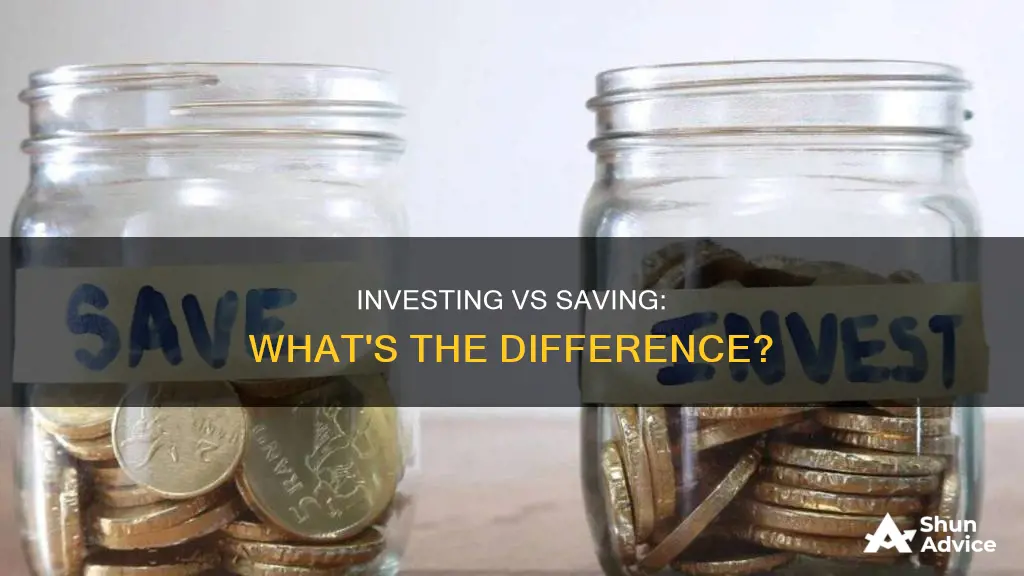
Saving and investing are both important concepts for building a sound financial foundation, but they are not the same thing. Saving typically results in lower returns with little to no risk, while investing allows for higher returns but comes with the risk of loss. Saving is best for short-term goals and emergencies, while investing is ideal for long-term goals. Both strategies are crucial for achieving financial security and building long-term wealth.
| Characteristics | Values |
|---|---|
| Risk | Saving is generally safer than investing, with virtually no risk. |
| Returns | Saving typically results in lower returns than investing. |
| Liquidity | Saving provides quick access to funds, while investing ties up money for the long term. |
| Complexity | Saving is usually straightforward and easy to do, while investing can be complex and requires research. |
| Purpose | Saving is for short-term goals and emergencies, while investing is for long-term goals and retirement. |
What You'll Learn

Saving for emergencies
- Start with a goal: Determine how much you want to save for emergencies. A common recommendation is to save three to six months' worth of living expenses. However, the amount you need to save may vary depending on your personal situation, such as job stability and the number of dependents.
- Create a budget: Analyse your income and expenses to create a realistic budget. Identify areas where you can cut back on spending and redirect that money towards your emergency fund.
- Reduce unnecessary expenses: Evaluate your spending habits and cut down on non-essential expenses such as eating out, subscription services, or luxury items. This can help you save a significant amount over time.
- Set up automatic transfers: Automate your savings by setting up regular transfers from your checking account to your emergency fund. This helps you save effortlessly without having to remember to transfer funds manually each time.
- Build your fund gradually: If you don't have an emergency fund yet, start small. Aim to save $500 to $1,000 initially, which can provide a financial cushion for minor emergencies. You can then work towards building a larger fund over time.
- Keep your emergency fund separate: Maintain your emergency fund in a separate account from your regular checking or savings account. This helps ensure that you don't accidentally spend the money and that it's easily accessible when needed.
- Choose the right account: Look for high-yield savings accounts or money market accounts that offer higher interest rates than traditional savings accounts. Compare different banks and credit unions to find the best option with minimal fees and easy access to your funds.
- Prioritise saving over investing: It's generally recommended to prioritise saving for emergencies before investing in riskier assets. Make sure you have a solid emergency fund in place before allocating a larger portion of your income towards investments.
Morningstar's Guide for Senior Investors
You may want to see also

Investing for retirement
When it comes to investing for retirement, there are several options to consider:
Income Annuity:
An income annuity is a contract with an insurance company where you pay a sum of money in exchange for regular income payments. It provides a steady, predictable source of income and offers tax advantages. However, there are challenges, such as limited liquidity and the risk associated with the insurance company's claims-paying ability.
Diversified Bond Portfolio:
With the recent increase in interest rates, bonds have become more attractive for retirees. A diversified bond portfolio can include U.S. Treasury securities, corporate debt instruments, government-issued bonds, mortgage-backed securities, and overseas bonds. While bonds offer a stream of income, they are subject to ordinary income tax rates, and there is a risk of principal loss if interest rates rise.
Total Return Investment Approach:
This approach involves investing in a diverse mix of stock and bond funds, taking into account your risk tolerance. It focuses on generating a "total return" by spending a portion of the average annual rate of returns, rather than just relying on income generated by holdings. However, there is no guarantee that funds will last throughout retirement, and the value of returns can vary from year to year.
Income-Producing Equities:
Some stocks provide income in the form of dividends. While dividend yields may not be as competitive as bond yields currently, they offer the potential for capital appreciation. It's important to review the dividend-paying history of companies and be prepared for potential fluctuations in dividend payouts.
Additionally, when investing for retirement, it's essential to consider your risk tolerance, time horizon, and overall financial goals. Retirement accounts, such as 401(k)s or IRAs, offer tax advantages and are ideal for long-term growth. Diversification is also key to minimizing risk and maximizing returns. This can be achieved by investing in a mix of asset classes, industries, company sizes, styles (growth and value stocks), and geographies.
Finally, it's worth noting that investing for retirement requires discipline and a long-term perspective. Market volatility and short-term losses can be challenging, but maintaining a consistent investment strategy and seeking professional advice can help you stay on track toward a comfortable retirement.
Sanlam Payout Speed: Unlocking Your Investments
You may want to see also

Pros and cons of saving
Saving money is an essential part of financial planning, but it has pros and cons that should be considered.
Pros of Saving
Saving provides a financial safety net for unexpected events and helps fund short-term goals like buying groceries, a new phone, or going on vacation. It also carries minimal risk of loss, especially if your savings are held in banks insured by the Federal Deposit Insurance Corporation (FDIC) or credit unions insured by the National Credit Union Administration (NCUA).
Cons of Saving
One of the main drawbacks of saving is missing out on potential higher returns from riskier investments. Savings can also lose purchasing power during periods of rising inflation. Additionally, keeping large amounts of cash in savings accounts may result in opportunity costs when that money could be invested in higher-yielding assets.
Pros of Investing
Investing offers the potential for higher returns than savings accounts and can help you achieve long-term financial goals, such as saving for retirement or buying a house. It also allows your wealth to grow over time through compounding and reinvestment.
Cons of Investing
Investing always involves some level of risk, and there is no guarantee of making money or even getting back your initial investment. It requires discipline and a long-term commitment, and it may require longer time horizons to see significant returns.
Investing Together, Retiring Together: A Couple's Guide to Financial Freedom
You may want to see also

Pros and cons of investing
Investing is a way to grow your money over time by putting it into financial instruments such as stocks, bonds, and mutual funds. While investing can be risky, it also has the potential to provide higher returns than simply saving. Here are some pros and cons of investing to consider:
Pros of Investing:
- Potential for higher returns: Investments such as stocks have historically provided higher long-term returns compared to savings accounts.
- Wealth accumulation: Investing is a powerful tool for building wealth over time, especially with a long-term investment horizon.
- Diversification: By investing in different types of assets, sectors, and geographies, you can reduce your overall investment risk.
- Liquidity: The stock market allows you to buy and sell stocks quickly and easily, providing liquidity for your investments.
- Beating inflation: Investing in stocks can help you stay ahead of inflation and protect your wealth.
Cons of Investing:
- Risk of loss: Investing always carries the risk of losing money, especially in the short term.
- Volatility: The stock market is volatile, with frequent ups and downs, which can be emotionally challenging for investors.
- Time and research: Investing requires time and effort to research and monitor your investments, as well as a long-term commitment.
- Taxes: Profitable stock sales may be subject to capital gains taxes, reducing your overall returns.
- Competition: Professional and institutional investors have more time, knowledge, and tools at their disposal, which can put individual investors at a disadvantage.
Chase Invest: Understanding Dividend Payments
You may want to see also

When to save and when to invest
Saving and investing are both important for building a sound financial future, but they are not the same thing. Saving is generally considered safer and better for short-term goals, while investing typically carries more risk and is better for long-term goals. Here are some guidelines on when to save and when to invest:
When to Save
- You have income but little or no cash on hand: It is recommended to build a cash savings balance that can cover at least three to six months' worth of living expenses in case of unexpected financial emergencies.
- You have short-term financial goals: If you are saving for a goal you plan to reach within the next three to five years, such as buying a home, paying for college, or funding a wedding, saving is generally a better option than investing. This is because investing typically involves more risk and is better suited for longer time horizons.
- You have high-interest debt: It is generally recommended to prioritise paying off high-interest debt, such as credit card balances, before investing. However, it is important to balance this with building an emergency fund, as living without one can be risky.
- You need the money within the next few years: If you will need to access your money in the near future, a high-yield savings account or money market fund is often the best option.
When to Invest
- You have a sufficient emergency fund and no high-interest debt: Once you have built up an emergency fund and paid off any high-interest debt, you may want to consider investing your extra money to grow your wealth over time.
- You are eligible for an employer match in your retirement account: If your employer offers a 401(k) or similar retirement savings plan with a company match, it is generally a good idea to contribute enough to receive the full match, as this is essentially free money.
- You are saving for long-term goals: Investing is crucial for achieving long-term financial goals, such as retirement, as it offers the potential for higher returns than saving.
- You have a long time horizon: Investing is ideal when you have a long time horizon, ideally many years, and won't need to access the money anytime soon. This gives your investments time to ride out any short-term downturns in the market.
- You can tolerate risk: Investing typically involves taking on some level of risk, so it is important to ensure you are comfortable with the potential for losses before investing.
In summary, saving is generally a good idea if you have short-term goals or need quick access to your money, while investing is better suited for long-term goals and offers the potential for higher returns, albeit with a higher level of risk. It is important to consider your financial situation, goals, and risk tolerance when deciding whether to save or invest.
Securities Investment 101: Navigating the Buying Process
You may want to see also
Frequently asked questions
Saving is for preserving your money, while investing is for growing it. When you save money in a bank account or CD, you earn a steady amount of interest and keep your principal intact. When you invest in the stock market or real estate, your returns can fluctuate from day to day. Also, you can withdraw savings from a bank account virtually anytime, whereas money you invest through a brokerage or retirement account may have some barriers to access.
Saving has many benefits such as providing a financial safety net for unexpected events, liquidity for purchases and other short-term goals, and being safe from loss. However, there are also some drawbacks to consider, such as missing out on potential higher returns from riskier investments. Savings can also lose purchasing power caused by periods of rising inflation.
Investing has the potential for higher returns than savings accounts, the ability to grow your wealth over time through compounding and reinvestment, and the opportunity to help you achieve long-term financial goals, such as saving for retirement or buying a house.
However, there are also some cons that should be considered. Investing always involves some level of risk, and there is no guarantee that you will make money or even get back what you've invested. It's important to do your research and understand the potential risks associated with different types of investments.
Saving is generally a good idea if you have short-term goals, such as saving for a new phone, laptop, or a vacation. Saving means putting your money into a safe and low-risk account, such as a savings account, money market account, or a certificate of deposit (CD). Savings products generally offer low returns but they also come with low risk. They are a good option if you need to access your money in the near future and can't afford to lose any of it.
If you don’t need the money for at least five years (or longer) and you’re comfortable taking some risk, investing the funds will likely yield higher returns than saving.
If you’re eligible for an employer match in your retirement account, such as a 401(k). Contributing enough money to ensure you receive the match is key because the match is like free money.
If you have built up your emergency fund and don’t carry any high-interest debt, investing your extra money can help you grow your wealth over time. Investing is crucial if you’re going to achieve long-term goals like retirement.







